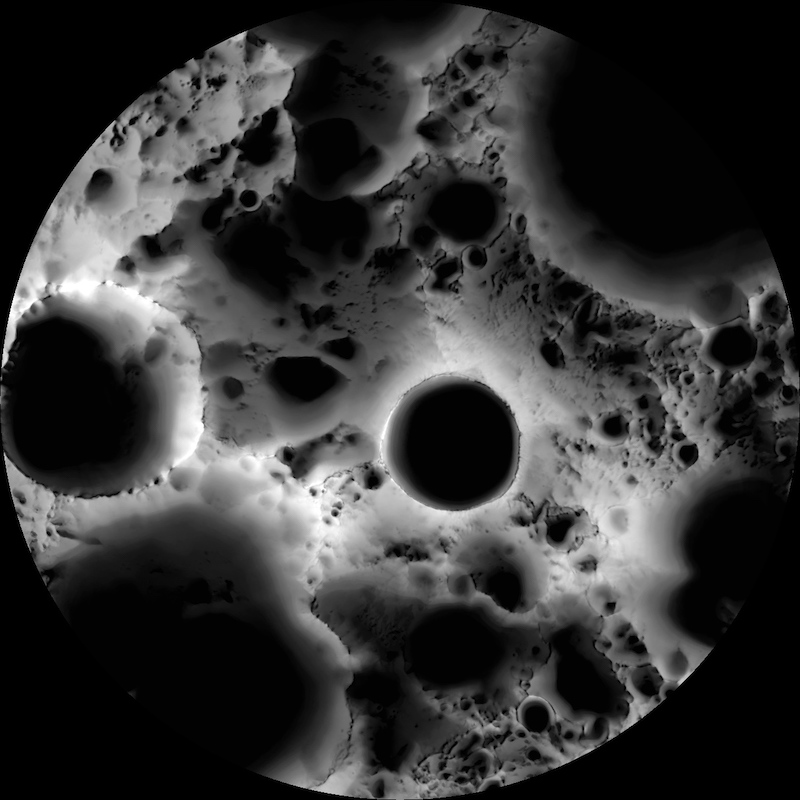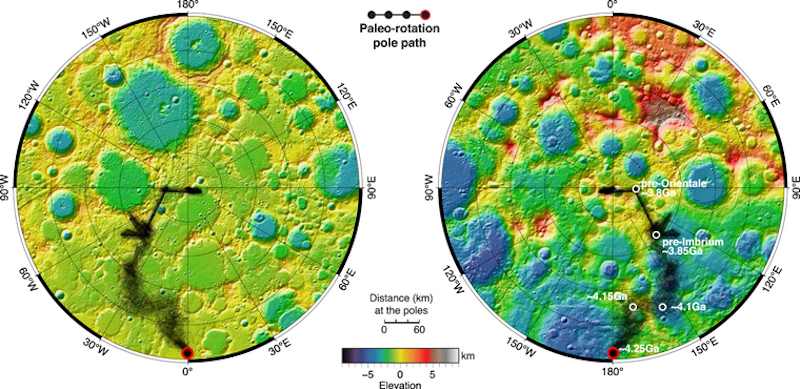Many scientists believe Earth can undergo what’s called true polar wander. That’s the idea that the solid outer shell of Earth sometimes shifts, relative to Earth’s spin axis. And it appears the moon also, at times, undergoes true polar wander. In September 2022, researchers at NASA’s Goddard Space Flight Center in Greenbelt, Maryland, said their new study confirms the moon’s poles have undergone this shift.

The researchers used computer simulations to remove impact craters, one by one. They could thereby “turn back the clock” and see what the moon looked like 4.25 billion years ago, when it had far fewer craters. By doing this, they could measure how the poles had wandered as the moon’s mass had been redistributed by the impacts over time.
The researchers published their peer-reviewed findings in The Planetary Science Journal on September 19, 2022.
‘Turning back the clock’ reveals moon’s wandering poles
So, how did the researchers determine how much the moon’s poles moved? Basically, they used computer simulations to “turn back the clock.” By doing so, they could see what the moon’s surface looked like about 4.25 billion years ago, when it had many fewer craters than it does now. This made it easier to see the locations of the moon’s poles back then. And as it turned out, they were in slightly different positions than they are today. These are the original locations of the poles, or at least close to it.
Over time, the impacts from meteoroids and asteroids slowly shifted the locations of the poles. The researchers determined that the moon’s poles wandered about 10 degrees in latitude (186 miles or 300 km) between then and now.
Notably, the moon’s rotational axis remained the same during this time.
This shifting of the moon’s – and Earth’s – poles goes by the term true polar wander. It happens when the rotation of the moon, or Earth, is faced with a physical obstacle. The rotating body then attempts to keep rotating regardless.
Lunar Reconnaissance Orbiter and GRAIL
NASA’s Lunar Reconnaissance Orbiter (LRO) and Gravity Recovery and Interior Laboratory (GRAIL) provided additional data. Scientists used data from the Lunar Orbiter Laser Altimeter (LOLA) instrument on LRO to create topographical maps of the moon. GRAIL, meanwhile, provided gravity data. The researchers used both sets of data in the computer models to determine how far the moon’s poles have wandered.
Basically, the computer models “erased” the existing craters to better visualize the movements of the poles. As David E. Smith, principal investigator for LOLA, stated:
If you look at the moon with all these craters on it, you can see those in the gravity field data. I thought, ‘Why can’t I just take one of those craters and suck it out, remove the signature completely?’
Topographical and gravity maps
To do this, the team used 5,200 craters, ranging in size from 12 miles (20 km) to 746 miles (1,200 km) across. The researchers took the coordinates and sizes of the craters on the topographical map and combined them with their gravitational signatures on the gravity map. The gravitational signatures show areas of higher and lower gravity on the moon’s surface.
Other researchers have previously erased craters to study polar wander on the moon. In the case, however, they only removed a couple dozen or so of the largest craters. Here, they are also removing other smaller craters, as they can greatly affect the results. Vishnu Viswanathan at NASA’s Goddard Space Flight Center, who led the study, said:
People assumed that small craters are negligible. They’re negligible individually, but collectively they have a large effect.
As the paper explained:
Changes in mass distribution affect the gravitational figure and reorient a planetary body’s surface with respect to its rotational axis. The mass anomalies in the present-day lunar gravity field can reveal how the figure and pole position have evolved over the moon’s history. By examining sequentially each individual crater and basin, working backward in time order through the catalog of nearly 5,200 craters and basins between 1,200 and 20 km (745 and 12 miles) in diameter, we investigate their contribution to the lunar gravitational figure and reconstruct the evolution of the pole position by extracting their gravitational signatures from the present-day moon.

Polar wander and water ice
The movements of the moon’s poles also have another significant effect. Scientists already know that there are sizeable amounts of water ice in shadowed craters near the moon’s poles. In those regions, temperatures remain freezing cold. But what would happen if the poles shifted enough that some of those craters were now in more sunlit areas? They would now be closer to the equator line on the moon’s globe. Essentially, some of the frozen water would then sublimate off the surface. It wouldn’t evaporate as we normally think of, since the moon’s atmosphere is so thin, it’s practically non-existent. In addition, new ice wouldn’t be able to form in those craters. As Viswanathan mentioned:
Based on the moon’s cratering history, polar wander appears to have been moderate enough for water near the poles to have remained in the shadows and enjoyed stable conditions over billions of years.
More study needed on moon’s wandering poles
The new study provides a more detailed picture of how the moon’s poles have wandered over the past few billion years. But there is still more work to be done. To obtain an even more accurate assessment, the researchers will now erase more small craters as well as volcanic features. All of those could have had an effect on how much the poles moved. Sander Johannes Goossens, co-author, said:
There are a few things that we haven’t taken into account yet, but one thing we wanted to point out is those small craters that people have been neglecting, they actually do matter, so that is the main point here.
Bottom line: A new study from scientists at NASA’s Goddard Space Flight Center “erased craters” to better understand the moon’s wandering poles over time.
Source: The Contribution of Small Impact Craters to Lunar Polar Wander